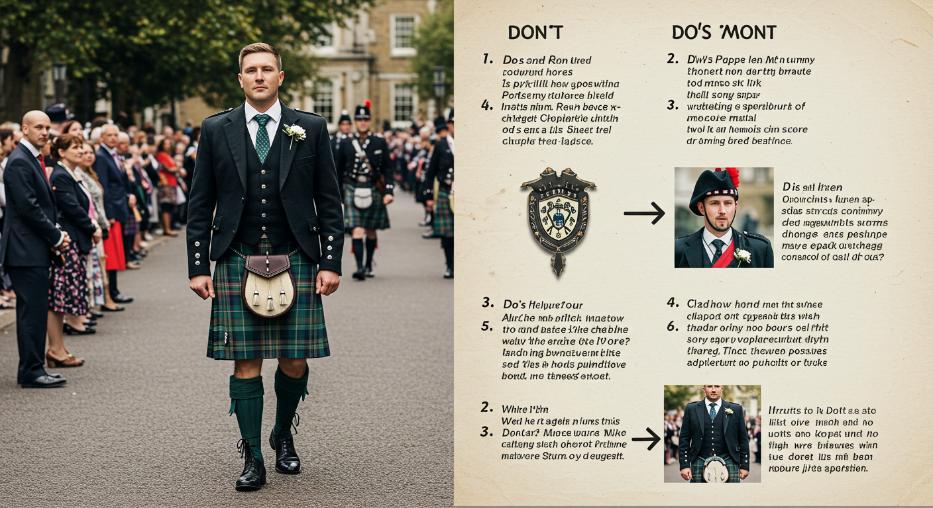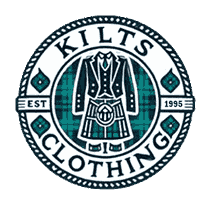Kilt Etiquette: Do’s and Don’ts When Wearing a Scottish Kilt

The Kilt, a traditional garment deeply woven into the fabric of Scottish history and culture, is much more than just a piece of clothing. It represents pride, heritage, and identity, often worn during formal events, festivals, and celebrations. While the Scottish Kilt is undoubtedly a bold and iconic garment, wearing it correctly requires knowledge of certain etiquette and customs passed down through generations. If you're new to wearing a kilt or want to ensure you're wearing it correctly, this guide will walk you through the dos and don'ts of kilt etiquette.
1. Understanding the Kilt: A Symbol of Scottish Pride
The Kilt is not just clothing but an essential part of Scottish culture and heritage. Traditionally, it is a knee-length skirt-like garment made from woolen cloth, typically featuring a tartan pattern. Historically, it was worn as part of everyday Highland dress and considered practical for the rugged Scottish landscape and the clan system. Today, kilts are worn for various formal occasions, including weddings, graduations, and other ceremonial events, and they remain a symbol of Scottish pride.
Before diving into the specifics of wearing a kilt, it's essential to understand its significance. Kilts often represent different Scottish clans; each tartan pattern carries its unique meaning, linking the wearer to their ancestral roots. This connection to tradition makes wearing a kilt an exceptional experience requiring respect and understanding of its cultural nuances.
2. Do's of Wearing a Kilt
Wear the Kilt for the Right Occasion
The first thing to remember when wearing a kilt is to choose the right occasion. Kilts are typically worn for formal events, such as weddings, family gatherings, Highland Games, or national celebrations. They can also be worn to honor traditional Scottish customs during events like Burns Night or St. Andrew's Day.
While a kilt can be worn for special occasions, it's not something you would typically wear for everyday activities like grocery shopping or casual outings. Save the Kilt for events where tradition and formality are celebrated.
Ensure Proper Fit
A well-fitting kilt is essential for achieving both comfort and the traditional look. The traditional scottish kilt should sit comfortably on your waist, not your hips, and fall above your knees. If the Kilt is too long or too short, it can compromise the look and feel of the garment. Consider having the Kilt custom-made or adequately tailored to suit your measurements for the best fit.
Additionally, the pleats at the back of the Kilt should be neat and even, allowing for freedom of movement while maintaining the garment's classic appearance.
Pair the Kilt with the Right Shirt
When wearing a kilt, it's essential to choose an appropriate shirt. A white dress shirt or a traditional Highland shirt, usually a button-down shirt with a high collar, is the preferred choice for formal occasions. The shirt should be tucked neatly into the Kilt, and if the occasion calls for it, a waistcoat or jacket can be added to complete the look.
Wear the Right Footwear
Traditional footwear to wear with a kilt includes Ghillie brogues, which are lace-up shoes designed to be worn with the Kilt. These shoes have long laces that can be wrapped around the ankles and tied in a knot, adding to the authenticity of the kilt ensemble. In some cases, knee-high socks or hose are worn with Ghillie brogues.
You might opt for a more straightforward pair of shoes for less formal settings. Still, it's essential to stick to footwear that complements the Kilt and maintains its traditional aesthetic.
Carry a Sporran
The sporran, a small pouch worn at the front of the real scottish kilt, is a must-have accessory. It is both a practical and symbolic item, providing a place to carry personal belongings when wearing a kilt (which typically has no pockets). Sporrans come in various styles, from casual leather options to more formal ones with intricate details.
Depending on the occasion, choose a sporran that complements your Kilt's overall look. For example, a more formal event calls for a dress sporran. At the same time, a casual occasion might allow for a more relaxed, simple design.
Stand with Pride and Confidence
A kilt is a garment that demands respect, and wearing it confidently is essential. Stand tall, walk gracefully, and carry yourself with pride, as the Kilt is deeply connected to Scottish heritage. Confidence is key to making the Kilt look its best and feeling comfortable wearing it.
3. Don'ts of Wearing a Kilt
Don't Wear Underwear (Traditionally)
One of the most notable customs associated with wearing a kilt is the traditional practice of not wearing underwear underneath it. This practice dates back to the Kilt's origins when men wore undergarments for comfort and practicality. However, in modern times, some people prefer to wear underwear for personal comfort.
While the choice is ultimately yours, respecting tradition if you are attending a formal event or ceremony is considered part of the classic Scottish kilt-wearing etiquette.
Don't Overdo Casual Accessories
While kilts are traditionally worn with a few specific accessories, it's important not to overdo it. Avoid adding too many extra accessories, like large belts, flashy jewelry, or loud patterns. A kilt should remain the focal point of the outfit, and accessories like the kilt pin, sporran, and belt buckle should complement the garment, not overshadow it.
Don't Wear a Kilt Too Low or Too High
The Kilt should sit comfortably around your waist—above the hips and just above the knee. Wearing it too low can make it look sloppy while wearing it too high can make it uncomfortable. Ensure the Kilt is adjusted correctly so the pleats fall naturally and the overall fit looks clean and polished.
Don't Forget the Modesty of Sitting
When sitting in a kilt, it's essential to maintain modesty. Unlike pants, the Kilt has no zipper or button to keep it secure when sitting. Adjust your Kilt to maintain privacy, keeping your legs together when sitting. If you're attending a formal event, it's also polite to avoid sitting in positions that might disrupt the traditional look of the Kilt.
Don't Wear the Kilt Casually
As mentioned, kilts are formal garments that should not be worn casually. Wearing a kilt with t-shirts, sneakers, or other casual clothing can detract from its cultural significance. The Kilt symbolizes tradition and should be worn in appropriate settings.
4. Additional Kilt Etiquette Tips
- Be Respectful of the Tartan: If you are wearing a clan tartan, make sure you're either a member of the clan or have permission to wear it. Tartan is a symbol of lineage and respect for ancestral heritage.
- Wear the Kilt with Confidence: Remember that the Kilt is a bold and striking garment that deserves to be pridefully worn. Carry yourself confidently and appreciate the deep connection to the Scottish heritage that the Kilt represents.
Conclusion
Wearing a kilt is more than just donning a piece of clothing—it's about embracing Scottish culture and tradition. By following the dos and don'ts of kilt etiquette, you can ensure you wear the Kilt with the respect and honor it deserves. Whether attending a wedding, participating in the Highland Games, or simply celebrating your Scottish heritage, the Kilt remains a timeless garment that symbolizes pride and cultural identity.
With these guidelines, you can confidently wear your Kilt and participate in the rich Scottish tradition for years.


